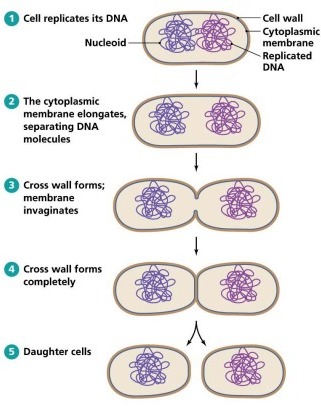Describe How Bacteria Reproduce Asexually Using Binary Fission
The 2 daughter cells are identical to the parent cell. Binary fission results in the formation of two.

Valentine S Day Science Escape Room Escape Room Science Games High School Science Class
Binary fission involves the division of a single cell which results in the.

. The primary form of reproduction in bacteria is binary fission. The coccal forms may divide in one or more than one plane. Do not have a nucleus.
Do not undergo cytokinesis. Bacteria reproduce by binary fission. Structures called pili assist bacteria.
Binary fission is how bacteria reproduce. The process of binary fission in bacteria. In order to undergo binary fission the bacterial cells must grow to a.
Asexual Reproduction in Bacteria. To replicate bacteria undergo the process of binary fission where a bacteria cell grows in size copies its DNA. Bacteria reproduce asexually by means of a process called.
Binary fission is used by most bacteria including Salmonella and Ecoli. Coli binary fission is required. This is a form of asexual reproduction which is common among bacteria.
The majority of bacteria present in food are Salmonella and E. Binary Fission in Bacteria Step 1- Replication of DNA. Bacteria undergo asexual reproduction by a process calle Binary fission.
A kind of cell division known as binary fission is common for bacteria to reproduce. Are able to produce spores. In this type of fission splitting of one bacterial cell into two equal bacterial cell take place.
Binary Fission It is a common and simple method of asexual reproduction in bacteria. The bacterial cells of the bacillus and the spirillum forms typically divide in a transverse plane which is at right angles to the long axis of the cell. Mazanec and Martinec studied cell division in Micrococcus cryophillus using electron microscope.
The process is thus called binary fission. What is asexual reproduction. Then the cells enlarges and divides into 2 new daughter cells.
Bacterial reproduction most commonly occurs by a kind of cell division called binary fission. The distance between the two DNA molecules grows as. The bacteria reproduce asexually using the process of binary fission.
This type of asexual reproduction involves two copies reproducing along with a single DNA molecule reproducing and attaching together to the membrane of the cell. Then the cells enlarges and divides into 2 new daughter cells. Terms in this set 5 Most prokaryotes reproduce asexually by _____ _____.
Binary fission is a simpler process than mitosis in plants and animals because bacteria. Step 2- Growth of a Cell. What Bacteria Uses Binary Fission.
Binary fission is similar in concept to the mitosis that happens in multicellular organisms such as plants and animals but its purpose is different. Which of the following is a form of reproduction in bacteria quizlet. In this process the bacterium which is a single cell divides into two identical daughter cells.
After copying the chromosome the bacterium starts to grow larger in preparation for binary. View the full answer. The single DNA molecule duplicates in this sort of asexual reproduction and both copies bind to the cell membrane at distinct places.
When cells divide by mitosis in the body of a multicellular organism they cause the organism to grow larger. Binary fission begins when the DNA of the bacterium divides into two replicates. Step 3-Segregation of DNA.
During binary fission the chromosome copies itself forming 2 genetically identical copies. In order to contain E. Asexual microorganisms like bacteria are prokaryotic organisms.
BIn bacteria three type of sexual reproduction take place which a. Bacterial binary fission is the process that bacteria use to carry out cell division. Bacteria reproduce through a process also known as binary fission.
Bacteria are prokaryotic organisms that reproduce asexually. An important feature of binary fission is the division of a single cell which results in genetically identical cells being produced to the genetically identical mother. Bacterial reproduction most commonly occurs by a kind of cell division called binary fission.
During binary fission the chromosome copies itself forming 2 genetically identical copies. Binary fission is how bacteria reproduce. It is a process by which a single bacterial cell simply di.
Bacteria are single-celled microbes and are one of the simplest forms of life on earth. Under favourable conditions bacteria multiply rapidly and may double in 10-15 minutes. This means that in just 7 hours one bacterium can generate 2097152 bacteria.
In this process of asexual reproduction the parent cell divides into two leading to two equal-sized daughter cells. Binary Fission The most common way by which the bacteria reproduce itself is the Binary Process. Binary fission This type is common in the most primitive unicellular organisms such as Simple algae Bacteria many protozoans such as Amoeba and Paramecium Binary fission happens under different conditions In suitable conditions The nucleus divides by mitosis The cell that represents the unicellular organism divides into 2 cells where each one of them.
Bacteria reproduce through binary fission. Containing just a single chromosome of DNA they lack a nucleus or other organelles found in most eukaryotic cells. Similarly you may ask how do most bacteria reproduce.
In this type of reproduction a single parent cell divides into two and forms two daughter cells which will be replicas of the parent. The bacterium uncoils and replicates its chromosome essentially doubling its content.

Bacteria Reproduction Study Guide Inspirit

Chapter 27 Bacteria Archaea Bacteria Eukaryotic Cell Organelles

Binary Fission And Other Forms Of Reproduction In Bacteria Department Of Microbiology
No comments for "Describe How Bacteria Reproduce Asexually Using Binary Fission"
Post a Comment